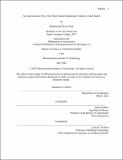| dc.description.abstract | The extant Khanqahs and Dargahs at Uchch archive the cultural imprint left by Jalāl al-Dīn Bukhāri (d. 1291) and his descendants on the urban fabric of the city. After the arrival and settlement of Bukhāri in the city, at the orders of his spiritual teacher Bahā’ al-Dīn Zakariya at Multan, the city emerged as a stronghold of the Suhrawardy Sufi order. Owing to its location on the peripheries of the Sultanate, and on the convergence of various major trade and military routes, the city was also a popular refuge for travelers, Sufis, deposed princes, artisans, and poets either escaping the onslaught of the Mongols in Central Asia during 13th century or seeking new patronage.
Though enigmatic in their own right, the 14th-15th century monumental tombs of Bahā’ al-Halīm, Bibī Jiwindī, and Ustād Nuriyā at Uchch have not been the subject of any dedicated study and have generally been ignored in scholarship. To remedy this dismissal, this thesis will analyze the monumental tomb architecture to demonstrate the Suhrawardy order’s attempt at entrenching itself at Uchch and establishing it as the new center of Suhrawardy learning and pilgrimage. Formally, this corpus operates within the Central Asian building traditions of Islamic mausolea, drawing inspiration from Seljuq and Samanid monuments. However, these Central Asian forms are made local through the distinct use of brick, differences in the structural fabric, and an indigenous program of ornamentation that predates the arrival of Islam in the Indus Valley.
The orthodoxy of Jalāl al-Dīn Bukhāri, and of his grandson who was also the future leader of the Khanqah Makhdūm Jahāniyān Jahāngasht, can be correlated to the modest tomb architecture used during their lifetime in which they were ultimately interred. Rejecting the indulgent behaviors of their Multani Suhrawardy counterparts, who commissioned monumental architecture of commemoration, the architecture at Uchch for the first three generations of the Bukhāri line of saints maintained a material modest. However, their leadership relented its orthodoxy when the Makhdūm Jahāniyān Jahāngasht’s younger brother, Rajān Qattāl, assumed leadership of the Khanqah in the late fourteenth century. This thesis will demonstrate that this revised attitude towards monumentality happened due to the unorthodoxy of the order’s leadership. Additionally, the introduction of this monumental program of architecture was a conscious attempt at the part of the leadership to establish Uchch as the new center for Suhrawardy learning. | |
